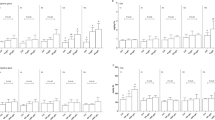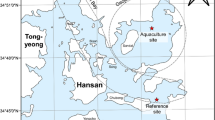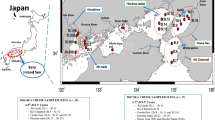Abstract
The persistence of malachite green (MG), and its metabolite leucomalachite green (LMG), in fish tissues is still unclear, leading to many trade disputes. In this research, we established and evaluated an HPLC method that could detect MG and LMG simultaneously, and then investigated the persistence of these two toxins in the tissues of juvenile perch (Lateolabrax japonicus) post sub-chronic MG exposure at 1.0 mg/L. Exposure lasted for 2 h everyday and was repeated six times. The perch were then placed in MG-free seawater for 100 d to eliminate the toxins. Results show that MG accumulated in the tissues, including the gills, liver, muscle, blood and viscera, and then was metabolized rapidly to LMG. The concentrations of these two toxins increased significantly with the accumulation process. In general, the highest concentrations of MG and LMG in all tissue exceeded 1 000 μg/kg, except for MG in the muscle. The order of accumulation levels (highest to lowest) of MG was gill>blood>liver>viscera>muscle, while that of LMG was liver>blood>gill>viscera>muscle. High levels of MG or LMG could persist for several hours but decreased rapidly during the elimination process. The concentration of LMG was much higher than that of MG during the experiment, especially in the gill, liver and blood. Therefore, the three tissues play important roles in toxin accumulation, biotransformation, and elimination. Although the MG and LMG concentrations in muscle were much lower than in other tissues, the content still exceeded the European minimum required performance limit (MRPL), even after 2 400 h (100 d) of elimination. This demonstrates that it is extremely difficult to eliminate MG and LMG from tissues of perch, and therefore use of these toxins is of concern to public health.
Similar content being viewed by others

References
Alderman D J. 1985. Malachite green-a review. J. Fish Dis., 8: 289–298.
Alderman D J, Clifton-Hadley R S. 1993. Malachite green: a pharmacokinetic study in rainbow trout, Oncorhynchus mykiss (Walbaum). J. Fish Dis., 16(4): 297–311.
Bose B, Motiwale L, Rao K V K. 2005. DNA damage and G2/M arrest in Syrian hamster embryo cells during Malachite green exposure are associated with elevated phosphorylation of ERK1 and JNK1. Cancer Letters, 230: 260–270.
Bergwerff A A, Kuiper R V, Scherpenisse P. 2004. Persistence of residues of malachite green in juvenile eels (Anguilla anguilla). Aquaculture, 233: 55–63.
Council Regulation. 1990. 2377/90/EC, Off. J. Eur. Commun., p.24.
Commission Decision. 2003. Amending Decision 2002/657/EC as regards the setting of minimum required performance limits (MRPLs) for certain residues in food of animal origin. O. J. Europ. Comm., 6: 38–39.
Culp S J, Blankenship L R, Kusewitt D F, Doerge D R, Mulligan L T, Beland F A. 1999. Toxicity and metabolism of malachite green and leucomalacite green during short-term feeding to Fischer 344 rats and B6C3F1 mice. Chem. Biol. Interact., 122: 153–170.
Culp S J, Beland F A, Heflich R H, Benson R W, Blankenship L R, Webb P J, Mellick P W, Trotter R W, Shelton S D, Greenlees K L, Manjanatha M G. 2002. Mutagenicity and carcinogenicity in relation to DNA adduct formation in rats fed leucomalachite green. Mutat. Res., 506/507: 55–63.
Halme K, Lindfors E, Peltonen K. 2004. Determination of malachite green residues in rainbow trout muscle with liquid chromatography and liquid chromatography coupled with tandem mass spectrometry. Food Addit. Contam., 21: 641–648.
Hajee C A J. 1997. Residues of mebendazole and malachite green in eel and trout: analytical and pharmacokinetical aspects, Dissertation at Utrecht University, Utrecht. p.183.
Hume P, Murby E J, Swarbrick A. 1997. Postcolumn electrochemical oxidation of leucomalachite green for the analysis of rainbow trout flesh using HPLC with absorbency detection. J. Liq. Chromatogr. R. T., 20(14): 2 269–2 280.
Jeong-ju N. 2005. Cancer-causing chemical found in local farm fish. The Korea Times, 6 October 2005.
Lee K C, Wu J L, Cai Z W. 2006. Determination of malachite green and leucomalachite green in edible goldfish muscle by liquid chromatography-ion trap mass spectrometry. J. Chromatogr. B, 843: 247–251
Máchová J, Svobodová Z, Svobodník J, Piacka V, Vykusová B, Kocová A. 1996. Persistence of malachite green in tissues of rainbow trout after a long-term therapeutic bath. Acta. Vet. Brno., 65: 151–159.
Manjanatha M G, Shelton S D, Bishop M, Shaddock J G, Dobrovolsky V N, Heflich R H, Webb P J, Blankenship L R, Beland F A, Greenlees K J, Culp S J. 2004. Analysis of mutations and bone marrow micronuclei in Big Blue rats fed leucomalachite green. Mutat. Res., 547: 5–18.
Melendre P M, Celada J D, Carral J M, Sáez-Royuela M, Aguiera A. 2006. Effectiveness of antifungal treatments during artificial incubation of the signal crayfish eggs (Pacifastacus leniusculus Dana. Astacidae). Aquaculture, 257: 257–265.
Mitrowska K, Posyniak A, Zmudzki J. 2005. Determination of malachite green and leucomalachite green in carp muscle by liquid chromatography with visible and fluorescence detection. J. Chromatogr. A, 1 089: 187–192.
Mittelstaedt R A, Mei N, Webb P J, Shaddock J G, Dobrovolsky V N, McGarrity L J, Morris S M, Chen T, Beland F A, Greenlees K J, Heflich R H. 2004. Genotoxicity of malachite green and leucomalachite green in female Big Blue B6C3F1 mice. Mutat. Res., 561: 127–138.
Munshi J S D, Huhges G M. 1991. Structure of respiratory islets of accessory respiratory organs and their relationship with the gill in the climbing perch, Anabas testudineus (Teleostei Perciforrnfs). J. Morpho., 209: 241–256.
Nowak B, De Guingand P. 1997. Effects of prophylactic treatments with malachite green on early life stages of rainbow trout. Aust. J. Ecotoxicol., 3(2): 141–146.
Poe W E, Wilson R P. 1983. Absorption of malachite green by channel catfish. Prog. Fish-Cult., 45: 228–229.
Rushing L G, Hansen Jr E B. 1997. Confirmation of malachite green, gentian violet and their leuco analogs in catfish and trout tissue by high-performance liquid chromatography utilizing electrochemistry with ultraviolet-visible diode array detection and fluorescence detection. J. Chromatogra. B., 700(1–2): 223–231.
Scherpenisse P, Bergwerff A A. 2005. Determination of residues of malachite green in finfish by liquid chromatography tandem mass spectrometry. Analytica. Chimica. Acta., 529: 173–177.
Srivastava S, Shiha R, Roy D. 2004. Toxicolgical effects of malachite green. Aquatic. Toxicol., 66: 319–329.
Schuetze A, Thomas H, Susanne J. 2008. Occurrence of residues of the veterinary drug malachite green in eels caught downstream from municipal sewage treatment plants. Chemosphere, 72(11): 1 664–1 670.
Valle L, Díaz C, Zanocco A L, Richter P. 2005. Determination of the sum of malachite green and leucomalachite green in salmon muscle by liquid chromatography-atmospheric pressure chemical ionisation-mass spectrometry. J. Chromatogra. A., 1 067: 101–105.
Veterinary Residues Committee. 2004. Annual Report on Surveillance for Veterinary Residues in Food in the UK. p.1–60
Yan S L, Gao Z X, Fang Y J, Cheng Y Y, Zhou H Y, Wang H Y. 2007. Characterization and quality assessment of binding properties of malachite green molecularly imprinted polymers prepared by precipitation polymerization in acetonitrile. Dyes. Pigments., 74: 572–577.
Yndestad M. 1993. Problems with drug residues in farmed fish. In: Haagsma N, Ruiter A, Czedik-Eysenberg P B eds. Conference on Residues of Veterinary Drugs in Food. Faculty of Veterinary Medicine, Utrecht, The Netherlands. p.115–124.
Author information
Authors and Affiliations
Corresponding author
Additional information
Supported by the Special Fund of Chinese Government for Basic Scientific Research Operations in Commonweal Research Institute (Yellow Sea Fisheries Research Institute) (No. 2007-qn-12), the Strategic Research Grant of the Databases and Risk Analysis of POPs in Aquatic Products (No. 2005DIB4J049), and the Standard System Research on Quality and Safety of Aquatic Products (No. 2004DEA70880)
Rights and permissions
About this article
Cite this article
Tan, Z., Xing, L., Guo, M. et al. Persistence of malachite green and leucomalachite green in perch (Lateolabrax japonicus). Chin. J. Ocean. Limnol. 29, 647–655 (2011). https://doi.org/10.1007/s00343-011-0141-4
Received:
Accepted:
Published:
Issue Date:
DOI: https://doi.org/10.1007/s00343-011-0141-4



